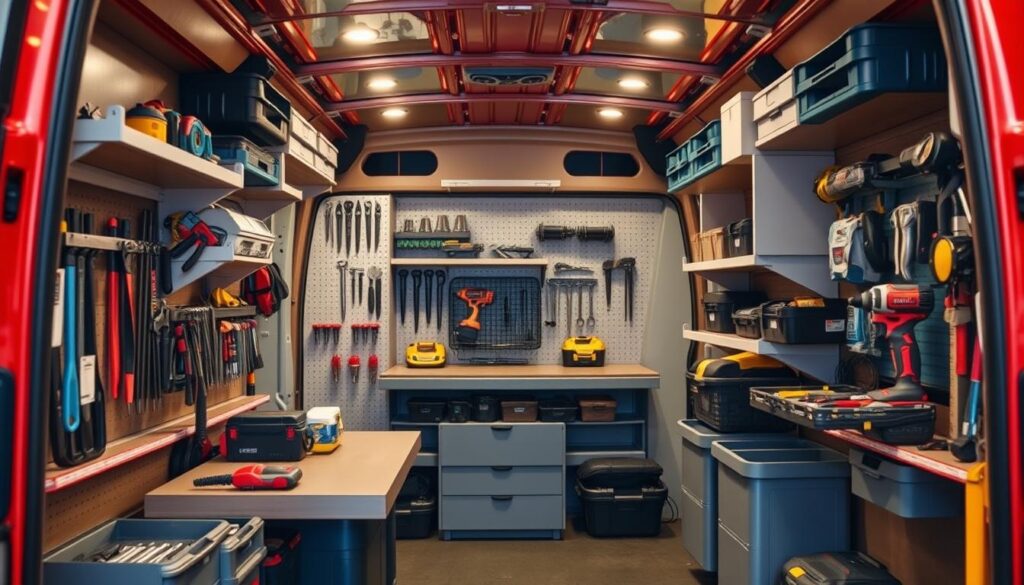Are you wasting valuable time searching for misplaced tools in your van? A well-organised workspace is crucial for tradespeople who rely on quick access to their equipment during jobs.
According to a survey by Express Employment Professionals, disorganisation costs companies around 6 working hours per week, representing a significant loss. An optimised van layout can significantly reduce this wasted time, improve productivity, and create a more professional image for your business.
By assessing your tool requirements, choosing the right storage solutions, and implementing effective organisation systems, you can transform your van into an efficient mobile workshop. This comprehensive guide will provide you with expert tips to maximise the available space in your work vehicle.
Key Takeaways
- Assess your tool requirements to optimise your van’s storage capacity.
- Choose appropriate storage solutions to keep your tools organised.
- Implement effective organisation systems to reduce wasted time.
- Maximise the available space in your work van with clever storage hacks.
- Improve productivity and create a more professional image for your business.
The Importance of an Organised Van Layout
A well-organised van layout can significantly impact your daily operations and overall business performance. When your van is organised, you can quickly locate the tools and equipment you need, saving you time and increasing your productivity throughout the day.
How Poor Organisation Affects Productivity
Poor organisation within your van can lead to inefficiencies and wasted time searching for misplaced items. A survey conducted by Express Employment Professionals found that organisation-wide disorganisation cost 57% of companies 6 working hours per week. This disorganisation not only affects your productivity but also has broader implications for your business.
The Financial Impact of Disorganisation
The financial cost of disorganisation extends beyond wasted time. It includes:
- Damaged or lost tools that need replacement.
- Unnecessary trips back to suppliers or workshops when needed tools can’t be located.
- Increased fuel consumption due to additional journeys caused by poor planning and organisation.
- A professional image that suffers when customers observe disorganisation, potentially affecting your ability to secure premium contracts.
- The importance of investing in proper storage solutions to improve efficiency and reduce operational costs over time.
Investing in a well-organised van layout is crucial for maintaining a competitive edge. By optimising your van’s layout, you can enhance your operational efficiency and reduce unnecessary expenses.
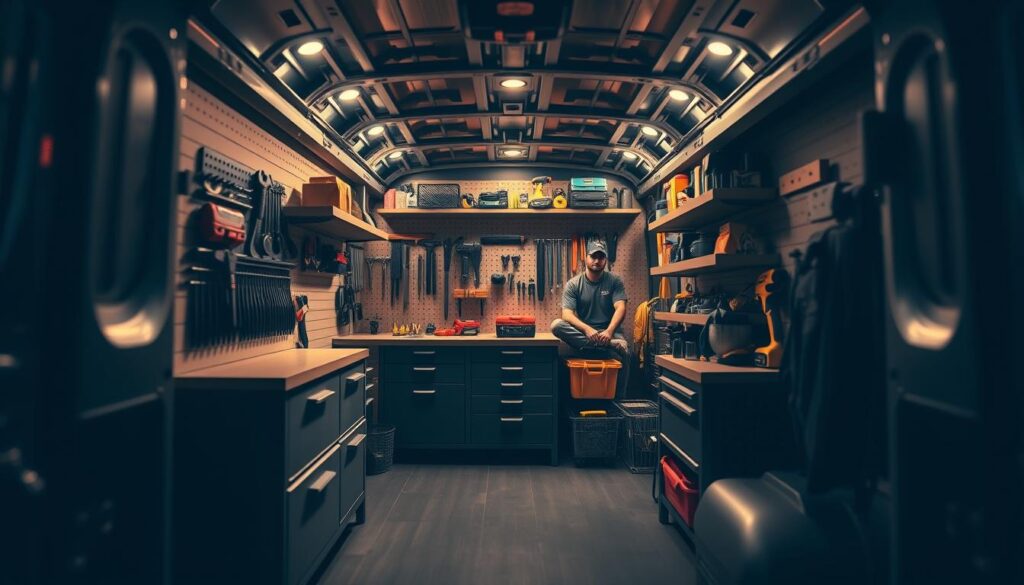
Assessing Your Tool Requirements
To optimise your van layout, it’s crucial to first assess your tool requirements. This involves understanding what tools you have, how you use them, and how you can store them efficiently in your van.
Determining Your Tool Hierarchy
You need to categorise your tools based on their importance and frequency of use. This will help you decide what tools should be easily accessible and what can be stored in less accessible areas. Consider creating a list or inventory of your tools to help with this process.
By prioritising your most-used tools, you can ensure that your van’s storage system is tailored to your specific needs. This might involve storing frequently used tools in easy-to-reach locations, such as near your workbench or at the main access point of your van.
Identifying Access Points and Workflow
Understanding how you access your van and the workflow of your tasks is crucial for optimising storage. You should consider whether you primarily work from the side door, rear doors, or both, and plan your storage layout accordingly.
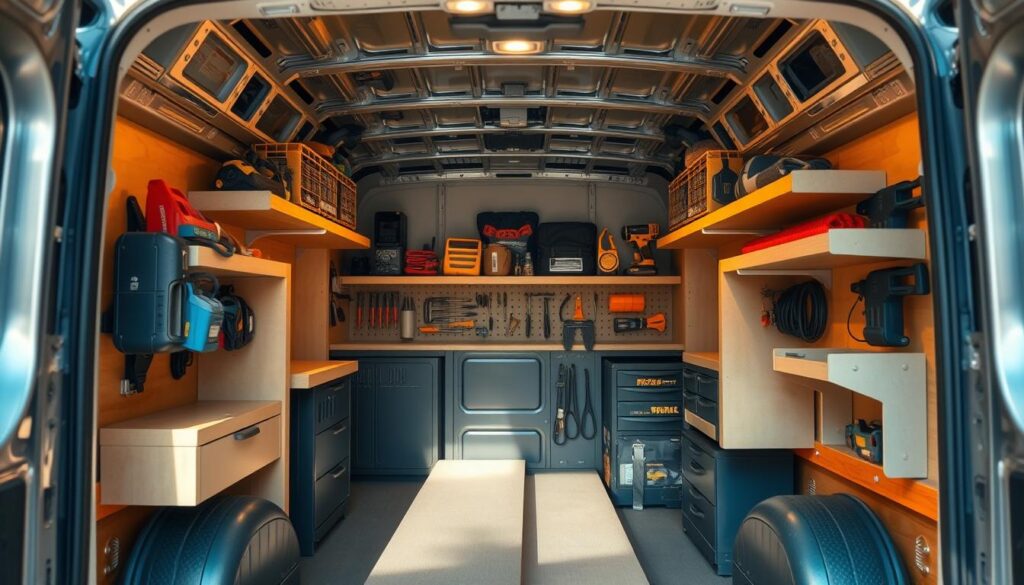
Analysing your typical workflow can also help you determine the most efficient storage solutions. For instance, tools used in sequence should be stored near each other to enhance efficiency. Additionally, consider whether you need a mobile workbench inside your van or if you primarily work outside the vehicle.
| Access Point | Workflow Consideration | Storage Solution |
|---|---|---|
| Side Door | Frequent access to tools | Shelving units near the side door |
| Rear Doors | Loading and unloading equipment | Racking systems at the rear |
| Inside the Van | Mobile workbench or storage for less frequently used tools | Modular storage systems or drawers |
Types of Van Storage Solutions
Effective van storage is not just about saving space; it’s about creating a more efficient work environment. The right storage solution can significantly enhance your workflow, reduce downtime, and improve overall productivity.
Open Shelving Systems
Open shelving systems are a popular choice for van organisation. They provide easy access to your tools and equipment, making it simpler to find what you need quickly.
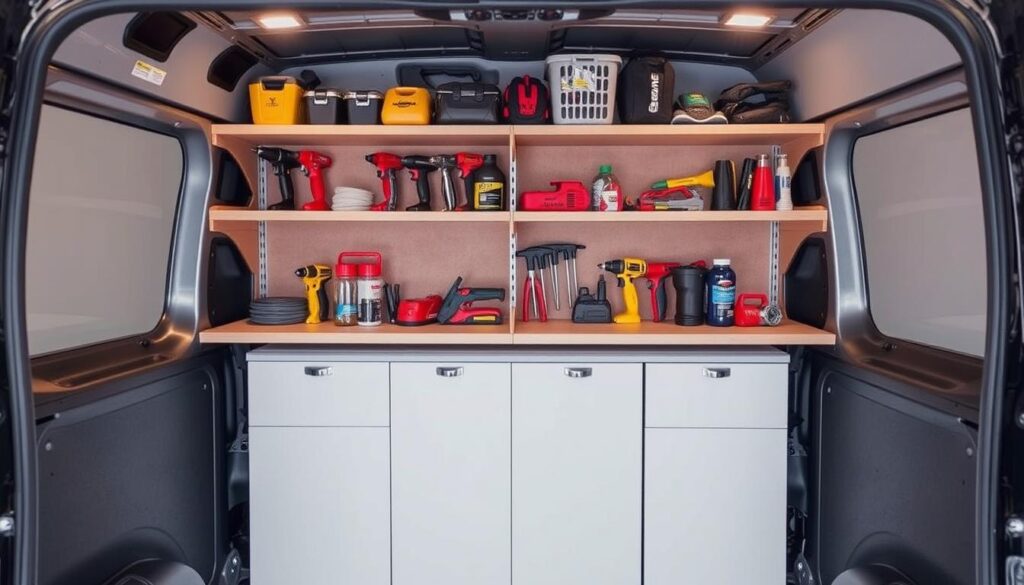
Modular Storage Systems
Modular storage systems offer flexibility and customisation. These systems allow you to configure the storage according to your specific needs, making it an ideal solution for varying tool requirements.
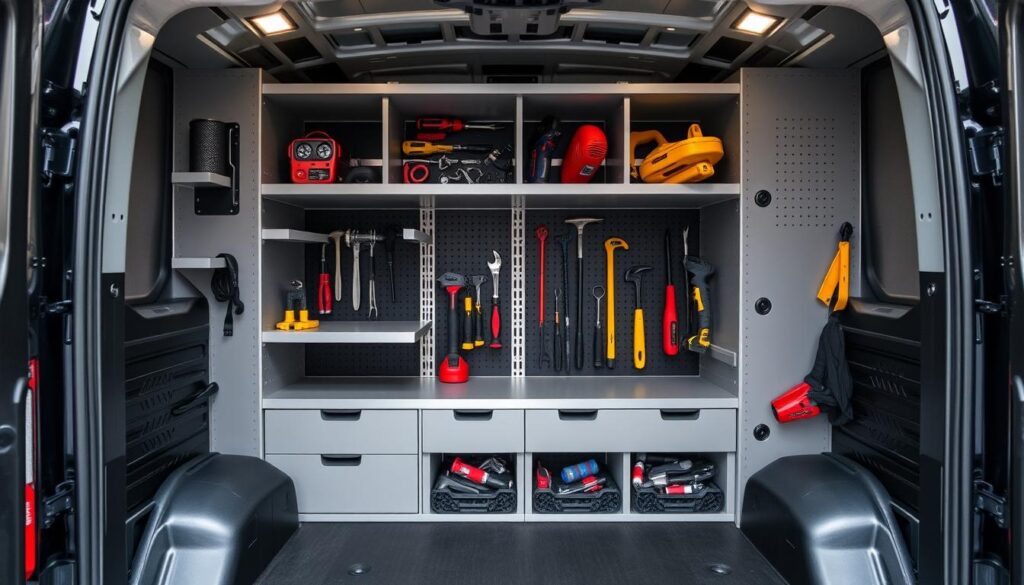
Pre-fitted Van Racking
Pre-fitted van racking systems are designed specifically for your van model, ensuring a perfect fit and maximum space utilisation. These systems are easy to install, lightweight, and efficient.
- Pre-fitted van racking systems are designed specifically for your van model, ensuring perfect fit and maximum space utilisation.
- These systems come with all necessary mounting hardware and align with your van’s existing anchor points for secure installation.
- Professional-grade materials like aluminium or steel provide durability while minimising weight impact on fuel efficiency.
- Installation typically takes hours rather than days, getting you back to work quickly with minimal downtime.
- Many pre-fitted systems include safety features like load restraints and crash-tested designs for peace of mind.
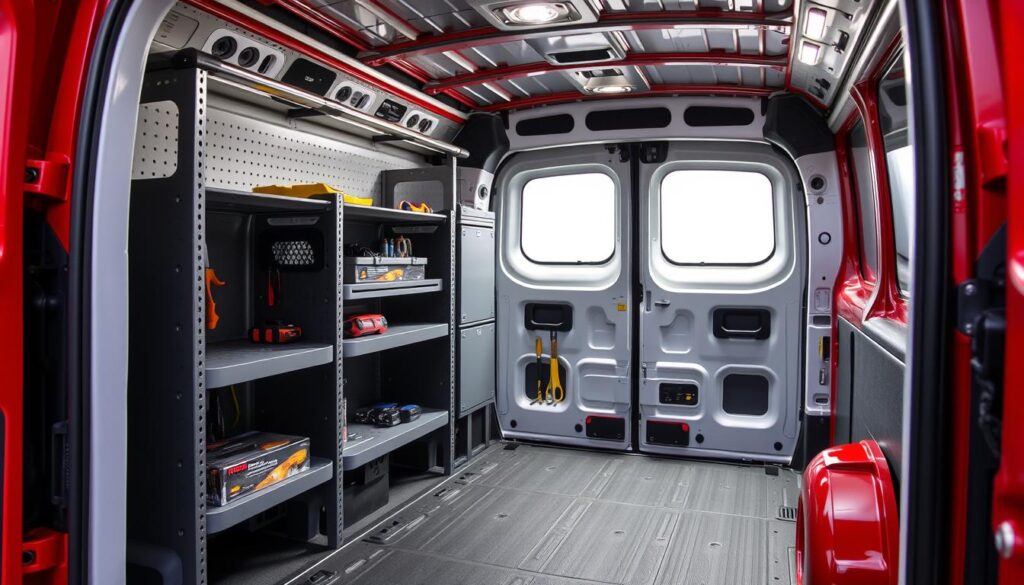
How to Optimise Van Layout for Tools
Creating an optimal van layout involves considering several key factors, including weight distribution and vertical space utilisation. To get the most out of your van, you need to carefully plan the layout of your tools and equipment.
Weight Distribution Principles
Proper weight distribution is vital to ensure your van remains stable and secure while driving. To achieve this, place heavier tools and equipment at the bottom and centre of the van, keeping the overall centre of gravity low. This will improve handling and reduce the risk of accidents.
Vertical Space Utilisation
Making the most of your van’s vertical space can significantly increase storage capacity. Consider installing shelving units or storage racks that go up to the ceiling. This will help keep frequently used tools within easy reach while keeping the floor clear for other equipment.
Creating Dedicated Zones for Different Tools
Dividing your van into dedicated zones for different types of tools can enhance organisation and efficiency. For example, you can have a zone for power tools, another for hand tools, and a separate area for materials and consumables. This will make it easier to find what you need when you need it.
Incorporating a Mobile Workbench
A mobile workbench can transform your van into a functional workshop on wheels. Consider a fold-down or slide-out design that can be stowed away when not in use to maximise space. You can also integrate power solutions into your workbench area for charging cordless tools.
A mobile workbench is particularly useful for tradespeople who need to work on-site. It provides a dedicated space for tasks, improving productivity and reducing the risk of damage to tools and equipment.
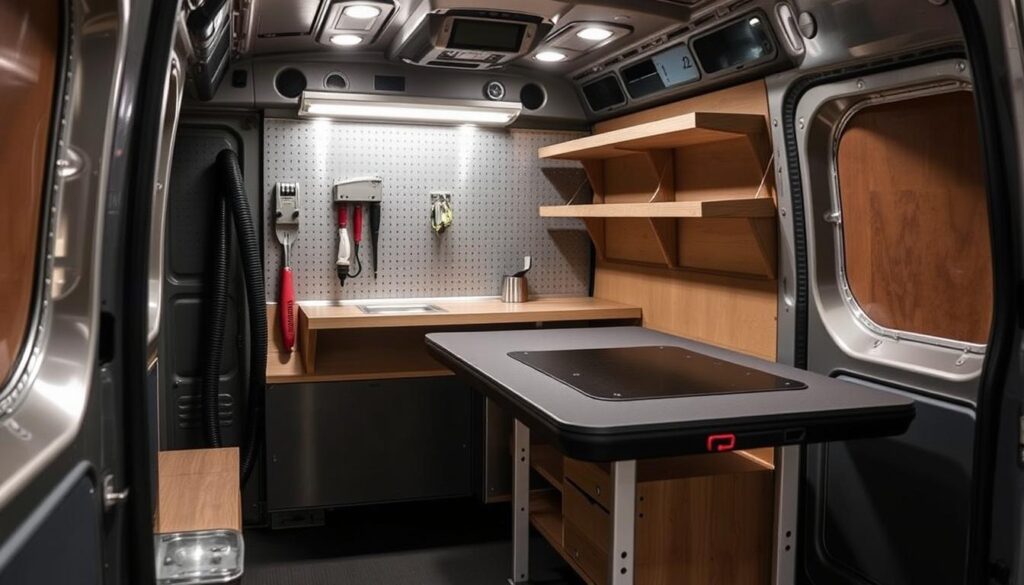
Clever Storage Hacks to Maximise Space
You can significantly enhance your van’s storage capacity by implementing a few clever hacks. Maximising space is essential for maintaining an organised and efficient workspace on wheels.
Hidden Floor Compartments
Utilising the floor of your van for storage can be highly effective. Hidden floor compartments can be created to store tools and equipment, keeping them out of the way but still accessible. This is particularly useful for storing items that you don’t need immediate access to.
Consider installing a false floor to create additional storage space. A false floor can be designed with sliding drawers or hinged sections, making it easy to access the stored items.
Door and Ceiling Storage Options
Don’t overlook the potential of your van’s doors and ceiling for storage. You can install storage bins or hooks on the doors to hold smaller items, and use the ceiling for storing less frequently used equipment. This helps to keep the main area of the van clutter-free.
Using Anchor Points for Flexibility
Anchor points provide a flexible way to secure tools and equipment within your van. By installing anchor points, you can easily reconfigure your storage layout as needed. This is particularly useful if you have a variety of tools that need to be secured in different ways.
False Floors for Long Tools and Materials
A false floor is a practical solution for storing long tools and materials. It creates a platform beneath which items can be stored horizontally across the van’s width. When designing a false floor, consider incorporating sliding drawers or hinged sections for easy access. Also, be mindful of the height implications to maintain adequate standing room inside the van.
Using durable, easy-to-clean materials for the false floor surface is advisable, as it will likely become your primary walking area.
Implementing Your Van Organisation System
To get the most out of your van, it’s essential to implement a tailored organisation system that suits your specific needs. This involves several key steps to ensure that your tools and equipment are stored efficiently and safely.
Preparing Your Van for Installation
Before installing your van organisation system, you need to prepare your van. This includes cleaning the interior thoroughly and removing any existing storage solutions. Assess the condition of your van’s interior to identify any areas that need repair or modification to support your organisation system.
Building a Solid Foundation
A solid foundation is crucial for your van organisation system. This means ensuring that the floor and walls of your van are sturdy enough to support the weight of your tools and equipment. Consider using van racking systems that are designed to maximise storage while keeping your van’s centre of gravity low.
Securing Tools and Equipment During Transit
Securing your tools and equipment during transit is vital to prevent damage and loss. As vans bounce around while driving, it’s crucial to keep everything fixed in place. You can use edges and bungee cords to secure items. For drawers and cabinets, consider using a hook or marine/RV locking system to prevent them from opening during sharp turns.
To ensure everything remains in place, implement the following measures:
- Use reliable locking mechanisms for all drawers, cabinets, and storage compartments.
- Apply non-slip matting on shelves to reduce tool movement.
- Install dividers or custom foam inserts in drawers to keep tools organised.
- Secure larger equipment with ratchet straps attached to designated anchor points.
- Test your securing methods by driving over rough terrain before fully loading your van.
By following these steps, you can create a van organisation system that not only maximises your storage capacity but also ensures that your tools and equipment are secure during transit.
Conclusion
An organised van is not just about storage; it’s about creating a mobile workspace that supports your business. By optimising your van layout for tools, you’re investing in increased productivity and professionalism.
The perfect system balances accessibility, security, and efficient use of space while accommodating your specific tool requirements. Whether you’re implementing a budget-friendly DIY solution or investing in a premium modular racking system, the principles of good organisation remain the same.
Regular maintenance and refinement of your storage system ensures it continues to meet your evolving needs as a tradesperson. Consider starting with a basic system and upgrading components over time as you identify specific needs and preferences through daily use.
The time saved through proper organisation compounds over weeks and months, potentially adding significant billable hours to your work year. An optimised work van not only improves your working efficiency but also projects professionalism to clients who see your organised mobile workshop.
By creating an efficient van setup, you’re able to get more onto the job in fewer trips, ensuring you have everything you need to successfully complete all aspects of the specific job at hand on the particular day. This proactive approach to mobile storage will help increase job day productivity.
In conclusion, optimising your van layout for tools and equipment is an investment that pays dividends. By implementing a well-designed storage system, you’re enhancing your daily operations and delivering exceptional service to your customers.
